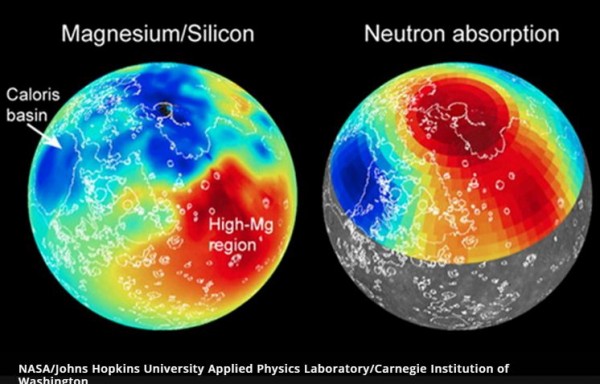New NASA Maps Expose More of Mercury's Secrets
| Arthur Dominic Villasanta | | Mar 18, 2015 02:41 AM EDT |
(Photo : NASA/Johns Hopkins/Carnegie Institution) Two new maps of Mercury reveal hidden formations on the planet's surface.
Never-before-seen formations on Mercury's surface have been revealed in two new maps created with data from NASA's MESSENGER spacecraft that's been orbiting the planet since 2004.
MESSENGER is an acronym of MErcury Surface, Space ENvironment, GEochemistry and Ranging. This 485 kilogram robotic NASA probe is the first ever spacecraft to orbit Mercury and studies the planet's chemical composition, geology and magnetic field.
Like Us on Facebook
The new maps show previously unidentified regions of Mercury. These regions or "geochemical terranes" have compositions significantly different from the crust surrounding them. Scientists said these zones provide insights into the formation of the outer surface of Mercury.
The maps also suggest the most recently identified features might have formed from the mantle and not from the planet's crust.
The maps were developed using MESSENGER's X-Ray Spectrometer (XRS) and Gamma-Ray Spectrometer (GRS) instruments that are being used to study the surface chemistry of Mercury.
Scientific analysis will reveal data about the concentrations of elements like potassium, uranium and sodium on the surface. The experiment will also give scientists the ratios of silicon to other elements on the planet's surface.
"The consistency of the new XRS and GRS maps provides a new dimension to our view of Mercury's surface," said lead author Shoshana Weider, of the Carnegie Institution of Washington.
"The terranes we observed had not been previously identified on the basis of spectral reflectance or geographical mapping."
The most visible of these unusual terranes is a large feature covering over five million square kilometers of the planet's surface. This terrane reveals the highest observed ratios of silicon to each of the elements of magnesium, sulfur and calcium. It also has some of the lowest aluminum-to-silicon ratios on the planet.
One possible explanation for the unusual region is that it stems from an impact that occurred long ago. The exposed mantle could have aided in the creation of the extremely large feature.
The second map using GRS shows the distribution across Mercury's northern hemisphere of elements that absorb thermal neutrons. Scientists were able to identify four distinct geochemical terranes by combining that information with previously obtained data.
"The crust we see on Mercury was largely formed more than 3 billion years ago," said Larry Nittler, deputy principle investigator of the mission and co-author on both studies.
"The remarkable chemical variability revealed by MESSENGER observations will provide critical constraints on future efforts to model and understand Mercury's bulk composition and the ancient geological processes that shaped the planet's mantle and crust."
©2015 Chinatopix All rights reserved. Do not reproduce without permission
EDITOR'S PICKS
-

Did the Trump administration just announce plans for a trade war with ‘hostile’ China and Russia?
-

US Senate passes Taiwan travel bill slammed by China
-

As Yan Sihong’s family grieves, here are other Chinese students who went missing abroad. Some have never been found
-

Beijing blasts Western critics who ‘smear China’ with the term sharp power
-

China Envoy Seeks to Defuse Tensions With U.S. as a Trade War Brews
-

Singapore's Deputy PM Provides Bitcoin Vote of Confidence Amid China's Blanket Bans
-

China warns investors over risks in overseas virtual currency trading
-

Chinese government most trustworthy: survey
-

Kashima Antlers On Course For Back-To-Back Titles
MOST POPULAR
LATEST NEWS
Zhou Yongkang: China's Former Security Chief Sentenced to Life in Prison

China's former Chief of the Ministry of Public Security, Zhou Yongkang, has been given a life sentence after he was found guilty of abusing his office, bribery and deliberately ... Full Article
TRENDING STORY

China Pork Prices Expected to Stabilize As The Supplies Recover

Elephone P9000 Smartphone is now on Sale on Amazon India

There's a Big Chance Cliffhangers Won't Still Be Resolved When Grey's Anatomy Season 13 Returns

Supreme Court Ruled on Samsung vs Apple Dispute for Patent Infringement

Microsoft Surface Pro 5 Rumors and Release Date: What is the Latest?










